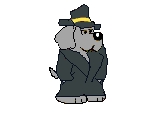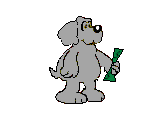
|
In order to prepare for your mission, there are several things you need to do…
|

|
I. Buy Supplies
A. You will need puppy food
It is best if the puppy continues on the same diet he was on before you acquired him, at least for the first few weeks. This prevents digestive upsets. If you plan to change the brand of food, do it gradually.
Ask the breeder how often to feed the puppy. The traditional schedule for young puppies is four times a day. As the puppy grows, this can be reduced to three times a day and then two times a day.
If the puppy is on a premium brand of puppy food you probably will not need to supplement, unless under a veterinarians orders. Excessive vitamins can be harmful to a growing puppy.
B. You will need food and water bowls
Preferably ones that are not easily tipped over
C. You will need a dog crate
A dog crate is an invaluable tool for raising a Weimaraner puppy. Canine Behaviorists have found that a den-like refuge (crate) helps calm dogs considered "hyperactive", "nervous", or "high strung." Dog crates can be advantageous to the puppy because:
He can have his own retreat where he can go when he is stressed, tired, or ill.
It will help him learn to control his bowels (dogs do not like to soil their sleeping area)
He can be taken on family outings instead of being left behind (provided the car is big enough to accommodate the crate)
He does not need to be confined to the basement, garage, or yard when you are away
He can use his crate as a storage area for his toys and treasures (if there is anything missing in the house, be sure to check the crate!)
He will feel more secure if he ever needs extended stay at a veterinarian, or if he needs to fly on an airline
Dog crates are advantageous to people because:
You don't have to worry about what is being soiled or destroyed while you are away
You can housebreak the puppy quicker and easier
You can effectively confine the puppy at times when he may be underfoot or overexcited
You can travel with the puppy without getting distracted driving, or worrying about having the hotel room torn up
**********Important Warning*********
The use of a dog crate must never be abused!!!! It is not a good idea to leave a puppy or a dog in a crate for an extended period of time. If you must leave him in the crate for several hours, such as during the day while you are at work, then let him loose when you are home. In addition, be sure to give him plenty of personal attention, and exercise when you return. Make sure the crate is large enough for him to stretch out in when he will be full-grown, and make sure he has water. A trick for keeping him occupied while you are away is to get a hollow marrowbone and fill it with peanut butter. He will spend hours trying to lick out every last drop! (More on Crate Training in the next section)
D. You will need a collar, lead, and identification tags
Size 12-16 usually fits most Weimaraner puppies
E. You will need toys for the puppy to chew on
Limit chew toys to one or two generic types so the puppy does not get confused about what is ok to chew, and what is not ok. Rawhide bones are not recommended, because larger pieces can be chewed off and swallowed.
F. You will need nail clippers, a nail file, or a sander such as a Dremmel tool, and styptic powder
Nail files and sanders are recommended over clippers, because it is easier to sand down to the quick rather than guess where the quick is, and cut. Styptic powder will help stop the bleeding incase the vein is accidentally cut. (More on nail trimming in the next section).
G. You will need a pooper scooper
It is certainly no fun stepping in the stuff!
H. You will need a Weimaraner proof garbage pail
This may be the hardest task…Let me know if you find one! Another option may be to lock the garbage pail in an area the puppy/dog can't get into.
|

|
II. You will need to set the ground rules
It is much easier to prevent problems than to fix problems with this particular breed. Therefore rules need to be set ahead of time. For example, will the full-grown Weimaraner be allowed on the furniture; or will he be allowed to sleep in bed with you? Set the rules up ahead of times and be consistent in enforcing them. Everyone in the family needs to use the same commands and consequences to enforce the rules.
|

|
III. You will need to clean the house and the yard area
When the puppy enters your home there should not be any small objects within his reach that he can swallow. Small hard objects, such as Lego blocks can perforate his intestines, and small soft objects such as panty hose can block his intestines. Both conditions can be fatal.
Make sure houseplants, many of which can be poisonous, are out of the puppy's reach.
Make sure the yard is safe as well, and the fence is in good repair. If you have a swimming pool in your yard, be sure to supervise the puppy until he learns to swim, and learns where the steps are. Gardens will need to be Weimaraner proofed (a difficult task indeed!)
|

|
IV. You will need to find a Veterinarian
Ask around for recommendations on a good veterinarian in your area. The veterinarian should not be overworked, and should take the time to answer questions. Make sure you have the number of a local after hours clinic in case of emergencies, and keep a basic first aid kit handy.
|

|
V. Make sure you have a good sense of humor and an abundance of patience.
The subject for your mission can be a real rascal at times. Good Luck!!
|








